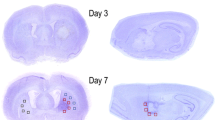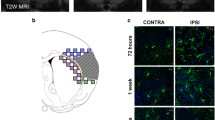Abstract
Oligogenesis plays an important role in functional recovery after ischemic stroke. We tested the hypothesis that oligogenesis and the maturation of oligodendrocyte progenitor cells (OPCs) vary in different brain regions using a rat transient middle cerebral artery occlusion (tMCAO) model. Compared to day 1, olig2+ OPCs and oligodendrocytes (OLGs) increased in the peri-infarct basal ganglia (BG) 7 days (44%) and 14 days (61%) after 2 h of MCAO; OPCs (PDGFRα+) and OLGs (CC1+) increased in this region 14 days after tMCAO by 139% and 126%, respectively. Although the olig2+ cells and OLGs did not increase significantly in the peri-infarct cortex (CTX), the OPCs increased in this region by 95% at day 14 vs. day 1 after tMCAO. The numbers of OPCs and OLGs remained low after an initial reduction at day 1 in the peri-infarct corpus callosum (CC). Correlation analyses showed that the numbers of olig2+ cells (r = 0.73, P = 0.03) and OLGs (r = 0.74, P = 0.02) correlated with local vessel density; however, the number of OPCs did not correlate with vessel density (r = 0.43, P = 0.24). Our data show that oligogenesis and the maturation of OPCs differ in various brain regions and the difference in regional angiogenic response is one of the potential reasons.








Similar content being viewed by others
References
Pantoni L, Garcia JH, Gutierrez JA. Cerebral white matter is highly vulnerable to ischemia. Stroke. 1996;27(9):1641–6.
Dewar D, Yam P, McCulloch J. Drug development for stroke: importance of protecting cerebral white matter. Eur J Pharmacol. 1999;375(1–3):41–50.
Volpe JJ. Cerebral white matter injury of the premature infant—more common than you think. Pediatrics. 2003;112(1 Pt 1):176–80.
Alix JJ. Recent biochemical advances in white matter ischaemia. Eur Neurol. 2006;56(2):74–7.
Arai K, Lo EH. Experimental models for analysis of oligodendrocyte pathophysiology in stroke. Exp Transl Stroke Med. 2009;1:6.
Lo EH, Dalkara T, Moskowitz MA. Mechanisms, challenges and opportunities in stroke. Nat Rev Neurosci. 2003;4(5):399–415.
Stys PK. Anoxic and ischemic injury of myelinated axons in CNS white matter: from mechanistic concepts to therapeutics. J Cereb Blood Flow Metab. 1998;18(1):2–25.
Yam PS, Patterson J, Graham DI, Takasago T, Dewar D, McCulloch J. Topographical and quantitative assessment of white matter injury following a focal ischaemic lesion in the rat brain. Brain Res Brain Res Protoc. 1998;2(4):315–22.
Micu I, Jiang Q, Coderre E, Ridsdale A, Zhang L, Woulfe J, et al. NMDA receptors mediate calcium accumulation in myelin during chemical ischaemia. Nature. 2006;439(7079):988–92.
Dewar D, Underhill SM, Goldberg MP. Oligodendrocytes and ischemic brain injury. J Cereb Blood Flow Metab. 2003;23(3):263–74.
McTigue DM, Tripathi RB. The life, death, and replacement of oligodendrocytes in the adult CNS. J Neurochem. 2008;107(1):1–19.
Arai K, Lo EH. Oligovascular signaling in white matter stroke. Biol Pharm Bull. 2009;32(10):1639–44.
Carroll WM, Jennings AR. Early recruitment of oligodendrocyte precursors in CNS demyelination. Brain. 1994;117(Pt 3):563–78.
Gensert JM, Goldman JE. Endogenous progenitors remyelinate demyelinated axons in the adult CNS. Neuron. 1997;19(1):197–203.
Tanaka K, Nogawa S, Ito D, Suzuki S, Dembo T, Kosakai A, et al. Activation of NG2-positive oligodendrocyte progenitor cells during post-ischemic reperfusion in the rat brain. Neuroreport. 2001;12(10):2169–74.
Gregersen R, Christensen T, Lehrmann E, Diemer NH, Finsen B. Focal cerebral ischemia induces increased myelin basic protein and growth-associated protein-43 gene transcription in peri-infarct areas in the rat brain. Exp Brain Res. 2001;138(3):384–92.
Tanaka K, Nogawa S, Suzuki S, Dembo T, Kosakai A. Upregulation of oligodendrocyte progenitor cells associated with restoration of mature oligodendrocytes and myelination in peri-infarct area in the rat brain. Brain Res. 2003;989(2):172–9.
Miyamoto N, Tanaka R, Shimura H, Watanabe T, Mori H, Onodera M, et al. Phosphodiesterase III inhibition promotes differentiation and survival of oligodendrocyte progenitors and enhances regeneration of ischemic white matter lesions in the adult mammalian brain. J Cereb Blood Flow Metab. 2010;30(2):299–310.
Arai K, Lo EH. An oligovascular niche: cerebral endothelial cells promote the survival and proliferation of oligodendrocyte precursor cells. J Neurosci. 2009;29(14):4351–5.
Koizumi J, Yoshida Y, Nakazawa T, Ooneda G. Experimental studies of ischemic brain edema. I: a new experimental model of cerebral embolism in rats in which recirculation can be introduced in the ischemic area. Jpn J Stroke. 1986;8:1–8.
Fisher M. Recommendations for advancing development of acute stroke therapies: stroke therapy academic industry roundtable 3. Stroke. 2003;34(6):1539–46.
Sicard KM, Fisher M. Animal models of focal brain ischemia. Exp Transl Stroke Med. 2009;1:7.
Li F, Han SS, Tatlisumak T, Liu KF, Garcia JH, Sotak CH, et al. Reversal of acute apparent diffusion coefficient abnormalities and delayed neuronal death following transient focal cerebral ischemia in rats. Ann Neurol. 1999;46(3):333–42.
Li F, Han S, Tatlisumak T, Carano RA, Irie K, Sotak CH, et al. A new method to improve in-bore middle cerebral artery occlusion in rats: demonstration with diffusion- and perfusion-weighted imaging. Stroke. 1998;29(8):1715–9.
Su H, Yang GY. Treatment of focal brain ischemia with viral vector-mediated gene transfer. Meth Mol Biol. 2011;686:429–46.
Spratt NJ, Fernandez J, Chen M, Rewell S, Cox S, van Raay L, et al. Modification of the method of thread manufacture improves stroke induction rate and reduces mortality after thread-occlusion of the middle cerebral artery in young or aged rats. J Neurosci Meth. 2006;155(2):285–90.
Nishiyama A, Komitova M, Suzuki R, Zhu X. Polydendrocytes (NG2 cells): multifunctional cells with lineage plasticity. Nat Rev Neurosci. 2009;10(1):9–22.
Gard AL, Pfeiffer SE. Two proliferative stages of the oligodendrocyte lineage (A2B5+O4− and O4+GalC−) under different mitogenic control. Neuron. 1990;5(5):615–25.
He Y, Cai W, Wang L, Chen P. A developmental study on the expression of PDGFalphaR immunoreactive cells in the brain of postnatal rats. Neurosci Res. 2009;65(3):272–9.
Iwai M, Stetler RA, Xing J, Hu X, Gao Y, Zhang W, et al. Enhanced oligodendrogenesis and recovery of neurological function by erythropoietin after neonatal hypoxic/ischemic brain injury. Stroke. 2010;41(5):1032–7.
Bhat RV, Axt KJ, Fosnaugh JS, Smith KJ, Johnson KA, Hill DE, et al. Expression of the APC tumor suppressor protein in oligodendroglia. Glia. 1996;17(2):169–74.
Olivier P, Fontaine RH, Loron G, Van Steenwinckel J, Biran V, Massonneau V, et al. Melatonin promotes oligodendroglial maturation of injured white matter in neonatal rats. PLoS ONE. 2009;4(9):e7128.
Karvinen H, Rutanen J, Leppanen O, Lach R, Levonen AL, Eriksson U, et al. PDGF-C and -D and their receptors PDGFR-alpha and PDGFR-beta in atherosclerotic human arteries. Eur J Clin Invest. 2009;39(4):320–7.
Zhang J, Li Y, Zhang ZG, Lu M, Borneman J, Buller B, et al. Bone marrow stromal cells increase oligodendrogenesis after stroke. J Cereb Blood Flow Metab. 2009;29(6):1166–74.
Qu R, Li Y, Gao Q, Shen L, Zhang J, Liu Z, et al. Neurotrophic and growth factor gene expression profiling of mouse bone marrow stromal cells induced by ischemic brain extracts. Neuropathology. 2007;27(4):355–63.
Liu R, Cai J, Hu X, Tan M, Qi Y, German M, et al. Region-specific and stage-dependent regulation of Olig gene expression and oligodendrogenesis by Nkx6.1 homeodomain transcription factor. Development. 2003;130(25):6221–31.
Acknowledgments
The authors thank Tony Pourmohamad, MS, for assistance with statistical analysis, Voltaire Gungab for assistance with manuscript preparation, and the other members of the UCSF BAVM Study Project (http://avm.ucsf.edu.) for their support.
This study was supported in part by grants R01 NS27713 (WLY), P01 NS44155 (WLY, HS), R21 NS070153 (HS) from the National Institutes of Health; AHA 10GRNT3130004 (HS) from the American Heart Association; and CIRM RC1-135 (SJP) from the California Institute of Regeneration Medicine. Lidan Jiang was partially supported by Dr. Feng Ling in the Department of Neurosurgery, Xuanwu Hospital, Capital Medical University, Beijing, China.
Author information
Authors and Affiliations
Corresponding author
Electronic Supplementary Materials
Below is the link to the electronic supplementary material.
Supplementary Figure 1
Infarct/atrophy size. Cresyl fast violet-stained sections show normal brain (dark blue) and infarct areas (pale blue). The infarct regions started to atrophy at day 7 and atrophied completely at day 14 after tMCAO. (JPG 125 kb)
Rights and permissions
About this article
Cite this article
Jiang, L., Shen, F., Degos, V. et al. Oligogenesis and Oligodendrocyte Progenitor Maturation Vary in Different Brain Regions and Partially Correlate with Local Angiogenesis after Ischemic Stroke. Transl. Stroke Res. 2, 366–375 (2011). https://doi.org/10.1007/s12975-011-0078-0
Received:
Revised:
Accepted:
Published:
Issue Date:
DOI: https://doi.org/10.1007/s12975-011-0078-0




